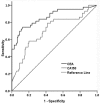Levels of CEA, CA153, CA199, CA724 and AFP in nipple discharge of breast cancer patients
- PMID: 26885008
- PMCID: PMC4723853
Levels of CEA, CA153, CA199, CA724 and AFP in nipple discharge of breast cancer patients
Abstract
The distinction between breast cancer and benign breast diseases with nipple discharge remains an important diagnostic challenge. The purpose of this study was to predict the potential usefulness of tumor markers in nipple discharge and to investigate the relationship of tumor markers and clinical characteristics with breast cancer.One hundred and eleven patients with nipple discharge received breast surgery from November 2013 to December 2014 were included in the study. We evaluated levels of five tumor markers (CEA, CA153, CA199, CA724 and AFP) prior to treatment. Patients were divided into two groups according to postoperative pathological results: 30 cases in breast cancer group and 81 cases in benign group. The relationships of clinical characteristics with breast cancer were investigated by multivariate analysis with a logistic regression model.It showed significant differences in levels of nipple discharge CEA (P < 0.001) and CA153 (P = 0.014), but not CA199 (P = 0.856), CA724 (P = 0.171), AFP (P = 0.834) among two groups. Logistic regression analysis demonstrated complaint, age, menopause, abnormal palpable mass, CEA and CA153 were associated with breast cancer. In summary, measurements of CA199, CA724 and AFP in nipple discharge are not of great clinical value. Detecting CEA and CA153 in nipple dischargecould potentially be used for the early detection of breast cancer with in high-risk populations.
Keywords: AFP; Breast cancer; CA199; CA724; diagnosis; nipple discharge.
Figures



Similar articles
-
Clinical application of serum CST4 combined with tumor markers in the diagnosis of digestive system malignant tumors.Oncol Lett. 2024 Jun 19;28(2):384. doi: 10.3892/ol.2024.14517. eCollection 2024 Aug. Oncol Lett. 2024. PMID: 38966578 Free PMC article.
-
Different Levels of CEA, CA153 and CA125 in Milk and Benign and Malignant Nipple Discharge.PLoS One. 2016 Jun 21;11(6):e0157639. doi: 10.1371/journal.pone.0157639. eCollection 2016. PLoS One. 2016. PMID: 27327081 Free PMC article.
-
Strategies for five tumour markers in the screening and diagnosis of female breast cancer.Front Oncol. 2023 Jan 23;12:1055855. doi: 10.3389/fonc.2022.1055855. eCollection 2022. Front Oncol. 2023. PMID: 36755860 Free PMC article.
-
Evaluating nipple discharge.Obstet Gynecol Surv. 2006 Apr;61(4):278-83. doi: 10.1097/01.ogx.0000210242.44171.f6. Obstet Gynecol Surv. 2006. PMID: 16551379 Review.
-
Bloody nipple discharge is a predictor of breast cancer risk: a meta-analysis.Breast Cancer Res Treat. 2012 Feb;132(1):9-14. doi: 10.1007/s10549-011-1787-5. Epub 2011 Sep 27. Breast Cancer Res Treat. 2012. PMID: 21947751 Review.
Cited by
-
Can serum ferritin serve as a biomarker for the prognosis of gynecological malignant tumors? A retrospective cohort study.Cancer Biomark. 2024;39(2):127-136. doi: 10.3233/CBM-230040. Cancer Biomark. 2024. PMID: 38160345 Free PMC article.
-
Multiple Metastases of the Liver and Lung After Breast-Conserving Surgery for Ductal Carcinoma In Situ Without Microinvasion of the Breast: A Case Report and Literature Review.Front Oncol. 2022 Apr 11;12:855899. doi: 10.3389/fonc.2022.855899. eCollection 2022. Front Oncol. 2022. PMID: 35480092 Free PMC article. Review.
-
Association between Helicobacter pylori infection and tumor markers: an observational retrospective study.BMJ Open. 2018 Aug 23;8(8):e022374. doi: 10.1136/bmjopen-2018-022374. BMJ Open. 2018. PMID: 30139906 Free PMC article.
-
CircRNAs as biomarkers of cancer: a meta-analysis.BMC Cancer. 2018 Mar 20;18(1):303. doi: 10.1186/s12885-018-4213-0. BMC Cancer. 2018. PMID: 29554887 Free PMC article.
-
Liquid Biopsy of Extracellular Vesicle-Derived miR-193a-5p in Colorectal Cancer and Discovery of Its Tumor-Suppressor Functions.Front Oncol. 2020 Aug 18;10:1372. doi: 10.3389/fonc.2020.01372. eCollection 2020. Front Oncol. 2020. PMID: 33014778 Free PMC article.
References
-
- Vargas HI, Romero L, Chlebowski RT. Management of bloody nipple discharge. Curr Treat Options Oncol. 2002;3:157–161. - PubMed
-
- Louie LD, Crowe JP, Dawson AE, Lee KB, Baynes DL, Dowdy T, Kim JA. Identification of breast cancer in patients with pathologic nipple discharge: does ductoscopy predict malignancy? Am J Surg. 2006;192:530–533. - PubMed
-
- Montroni I, Santini D, Zucchini G, Fiacchi M, Zanotti S, Ugolini G, Manaresi A, Taffurelli M. Nipple discharge: is its significance as a risk factor for breast cancer fully understood? Observational study including 915 consecutive patients who underwent selective duct excision. Breast Cancer Res Treat. 2010;123:895–900. - PubMed
-
- Lamerz R. CEA determination in the follow-up of extracolorectal neoplasms. Int J Biol Markers. 1992;7:171–178. - PubMed
LinkOut - more resources
Full Text Sources
